Explore the enchanting beauty of Punakha, Bhutan's ancient capital, renowned for its splendid Punakha Dzong, the serene Sangchhen Dorji Lhuendrup Nunnery, and the iconic Khamsum Yulley Namgyal Chorten. Whether you seek adventure with Mo Chhu river rafting, blessings at Chimi Lhakhang, or simply wish to explore the historic sites in Punakha, this guide promises a comprehensive overview of the best sights in Punakha. Dive into the rich cultural heritage and stunning natural landscapes that make Punakha a top destination for travelers looking to enrich their experience with history, spirituality, and breathtaking views.
At Amen Bhutan Tours and Treks, we pride ourselves on being the premier choice for exploring the top 10 places to visit in Punakha. Our expertly crafted tours are designed to immerse you in the rich tapestry of Punakha's cultural heritage and breathtaking natural beauty. From the majestic Punakha Dzong to the serene heights of Khamsum Yulley Namgyal Chorten, and the thrilling Mo Chhu river rafting adventures, we ensure a seamless and enriching travel experience. Join us to discover why we are widely recognized as the best company to guide you through the historic sites and stunning landscapes of Punakha, making every moment of your journey unforgettable.
Punakha Dzong
Punakha Dzong, often referred to as the 'Palace of Great Happiness', is not only one of Bhutan's most beautiful and historic dzongs but also a pivotal structure in the religious and administrative life of the country. Situated at the confluence of the Pho Chhu and Mo Chhu rivers, it serves as both a religious sanctum and a fortress. Here are some key points that highlight the significance and beauty of Punakha Dzong:

- Strategic Location: Positioned at the junction of two major rivers, the dzong benefits from the natural defense provided by the waters, as well as the stunning views of the surrounding valleys.
- Architectural Marvel: Known for its impressive structure, the dzong showcases a traditional Bhutanese architectural style, featuring intricate woodwork and beautiful interior courtyards.
- Historical Significance: Constructed in the 17th century, it has played a central role in Bhutan's history, serving as the coronation site of all Bhutanese kings.
- Religious Importance: It houses many sacred relics from the days when it was the religious and administrative center of the country. It is still the winter home of the Je Khenpo, the Chief Abbot of Bhutan.
- Cultural Festivities: The dzong is the venue for the annual Punakha Drubchen and Tshechu festivals, which draw thousands of locals and tourists to witness the vibrant mask dances and cultural celebrations.
- Art and Craftsmanship: Visitors can admire the exquisite murals and carvings that depict Buddhist teachings and stories, which are a testament to the skill of Bhutanese artisans.
Punakha Dzong is not just a fortress but a treasure trove of history, culture, and art. Its strategic importance, architectural beauty, and religious significance make it a cornerstone of Bhutanese heritage and a must-visit for anyone traveling to Punakha. This majestic dzong continues to awe visitors with its grandeur and the serenity of its spiritual ambiance.
Khamsum Yulley Namgyal Chorten
Khamsum Yulley Namgyal Chorten stands as a magnificent example of Bhutanese architecture and religious tradition. This beautiful stupa, located on a picturesque hill above the Punakha Valley, was built to promote peace, stability, and harmony in the ever-changing world. Here are some key aspects of this unique structure:

- Purpose and Significance: The chorten was built under the patronage of the Queen Mother, Her Majesty Ashi Tshering Yangdon Wangchuck. It was constructed to remove negative forces and promote peace, stability, and harmony in the world, according to Tantric Buddhist scriptures.
- Architectural Design: Unlike many other traditional Bhutanese religious structures, Khamsum Yulley is uniquely designed. It spans several floors, each of which represents different aspects of the Tantric Buddhist pantheon and is characterized by elaborate and symbolic paintings and sculptures, all of which have been created by Bhutanese artisans to ensure religious authenticity and artistry.
- Scenic Location: The chorten is situated atop a beautiful hill that offers panoramic views of the Punakha Valley. The hike to the chorten, through lush rice fields and up a moderately steep trail, is as scenic as it is spiritually uplifting.
- Ceremonial Importance: It is not just a monument to behold but serves an active ceremonial purpose in the spiritual life of the local community. The site is often used for rituals and ceremonies dedicated to the well-being of Bhutan.
- Tourist Attraction: The site has become a popular destination for both pilgrims and tourists. Visitors are often struck by the tranquility of the location and the detailed artistry of the building, which offers insights into the spiritual and cultural ethos of Bhutan.
Khamsum Yulley Namgyal Chorten is a quintessential representation of Bhutan's commitment to peace and spiritual harmony. Visiting the chorten provides not only a window into the profound depth of Bhutanese spiritual practices but also offers a tranquil retreat from the busyness of modern life, nestled in the heart of one of Bhutan's most beautiful landscapes.
Sangchhen Dorji Lhuendrup Nunnery
Sangchhen Dorji Lhuendrup Nunnery is a serene and spiritually enriching destination nestled in the picturesque hills of Punakha, Bhutan. This modern temple and nunnery complex serves as both a religious retreat and a center for learning, providing a harmonious blend of spiritual practice and community service. Here are some significant highlights of the Sangchhen Dorji Lhuendrup Nunnery:
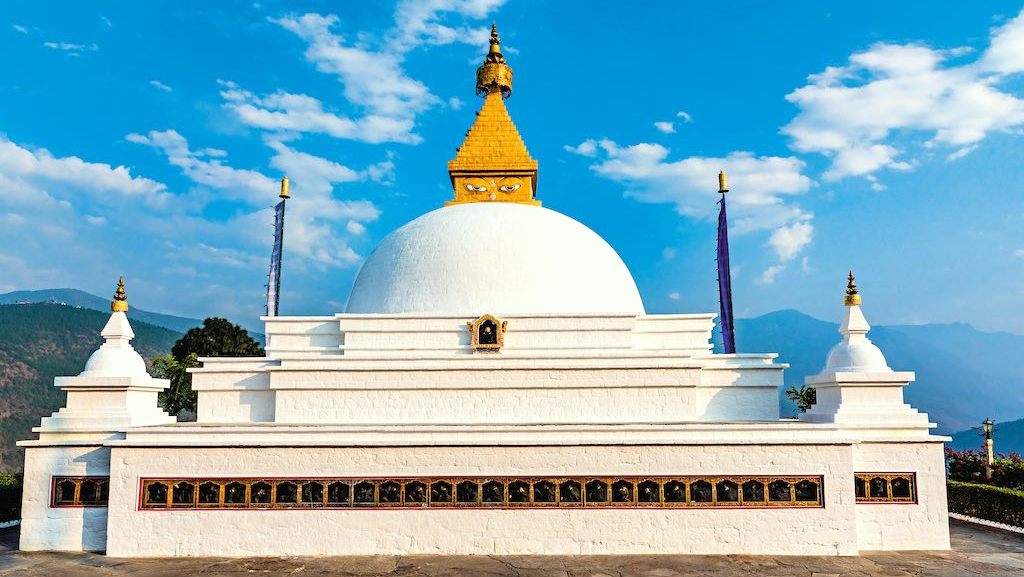
- Dual Purpose: The nunnery is not only a spiritual haven but also an educational institution where nuns receive training in both spiritual and secular subjects. They study traditional Buddhist scriptures alongside modern subjects, which helps integrate religious life with practical skills.
- Architectural Splendor: The architecture of the nunnery is a marvel, reflecting traditional Bhutanese design with a touch of modernity. Its location on a hilltop offers panoramic views of the Punakha and Wangdue valleys, enhancing the spiritual ambiance with breathtaking natural beauty.
- Artistic Heritage: Inside, the nunnery is adorned with beautiful murals and statues that represent significant Buddhist deities and teachings. The art serves as both a focus for meditation and a tool for educating the nuns and visitors about Buddhist philosophy.
- Community Involvement: Sangchhen Dorji Lhuendrup Nunnery plays a crucial role in the local community. The nuns participate in various social and educational programs, and the nunnery often hosts religious ceremonies and festivals that are open to the public.
- Tourist Attraction: For visitors, the nunnery offers a peaceful retreat from the hustle and bustle of daily life. The serene environment, combined with the spiritual practices observed here, provides a unique insight into the role of women in Buddhism in Bhutan.
Sangchhen Dorji Lhuendrup Nunnery is not just a place of worship but a vibrant center of learning and community engagement. It represents a progressive facet of Buddhist practice by empowering women to take leading roles in religious education and community service, all within the breathtaking setting of the Himalayan landscape. This nunnery is a must-visit for anyone seeking a deeper understanding of Bhutanese culture and spirituality.
Chimi Lhakhang
Chimi Lhakhang, fondly known as the Fertility Temple, is a distinctive and revered site located in the Punakha District of Bhutan. This temple, small yet deeply symbolic, stands on a round hillock and is particularly famous for its association with Lama Drukpa Kunley, the "Divine Madman," known for his unconventional approach to Buddhism. Here are the key aspects of Chimi Lhakhang that attract both local devotees and international tourists:
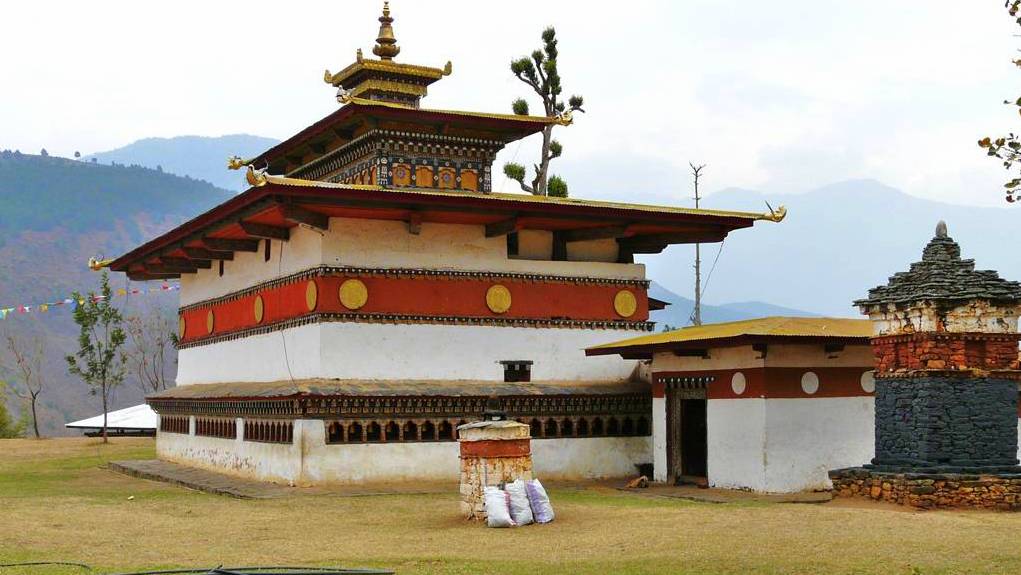
- Historical Background: The temple was built in 1499 by the 14th Drukpa hierarch, Ngawang Choegyel, as a tribute to Lama Drukpa Kunley. Lama Drukpa Kunley is celebrated for his humorous, outrageous, and sometimes provocative methods of teaching Buddhism, which often included songs, humor, and sexual overtones—unconventional methods that appealed to the common people.
- Symbol of Fertility: Chimi Lhakhang is renowned for its power to bless couples who wish to conceive a child. It's a common practice for childless couples to visit the temple to receive a blessing, which involves a traditional ritual performed by the resident monks using a wooden phallus.
- Cultural Significance: The temple is adorned with phallic symbols, paintings, and carvings which are believed to ward off evil spirits and promote fertility. These symbols reflect the teachings of Drukpa Kunley, who used sexual imagery and references in his teachings.
- Pilgrimage Site: It is a popular pilgrimage site for Bhutanese families who often visit to seek blessings for their children or for fertility if they are childless. The walk to the temple, through fields and across a small village, is an integral part of the pilgrimage, offering a moment of reflection amidst serene landscapes.
- Tourist Attraction: For tourists, Chimi Lhakhang offers a unique cultural insight into a less-discussed aspect of Buddhist spirituality. The temple provides not only a historical context but also a glimpse into Bhutanese folklore and the deep-rooted beliefs in blessings and protection.
Chimi Lhakhang is a compelling testament to Bhutan’s rich religious traditions, interwoven with local legends and historical narratives. Whether visiting for spiritual reasons or simply to experience a unique aspect of Bhutanese culture, Chimi Lhakhang remains an enchanting and memorable destination within the lush landscapes of Punakha.
Punakha Suspension Bridge
The Punakha Suspension Bridge is one of the longest and most scenic suspension bridges in Bhutan, offering both adventure and a spectacular perspective of the landscape surrounding the Po Chhu River. Spanning an impressive length, this bridge connects the Punakha Dzong with the Punakha town and nearby villages, making it a vital and historic link in the region. Here are some notable features of the Punakha Suspension Bridge:
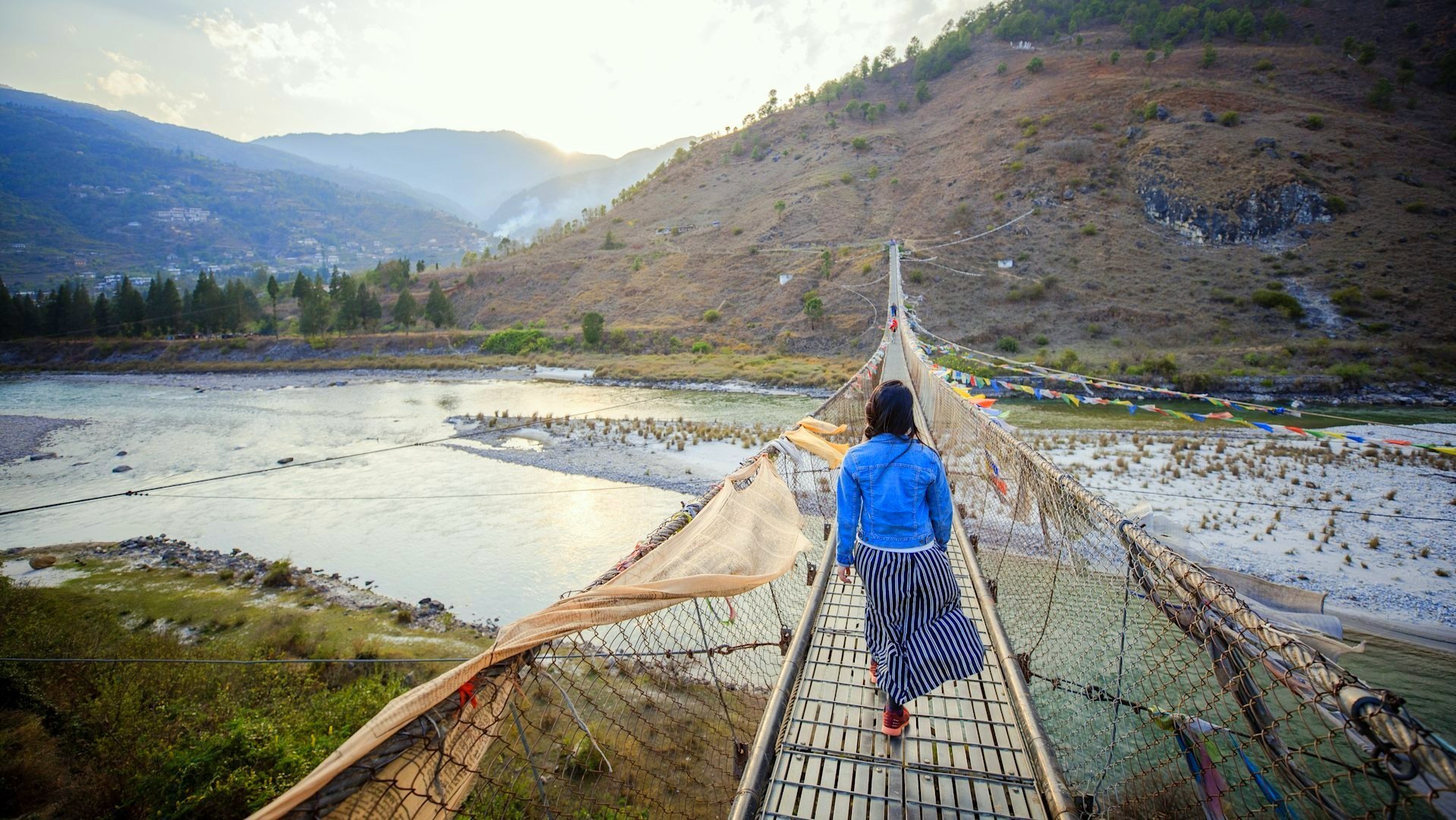
- Impressive Engineering: The bridge is an architectural marvel, celebrated for its length and the engineering prowess required to span the wide and fast-flowing Po Chhu River. Its robust cables and wooden planks are well-maintained to ensure safety for all who cross.
- Scenic Views: Walking across the bridge offers breathtaking views of the river below, the lush valley, and the towering mountains in the distance. The natural scenery provides a picturesque backdrop that is particularly captivating during the spring and autumn months.
- Cultural Significance: The bridge is not just a physical structure but also holds cultural importance in the community. It is used during local festivals when residents of nearby villages cross the river to reach the Punakha Dzong for various ceremonies.
- Tourist Attraction: For visitors, the bridge provides a thrilling experience as it sways gently above the river. It's a popular spot for photographers and adventure seekers looking for that perfect shot of Punakha’s natural beauty and architectural heritage.
- Accessibility: The bridge enhances the accessibility of remote villages, facilitating easier movement for locals and tourists alike. It connects historical and religious sites to the main areas, making it an essential part of travel itineraries in Punakha.
Punakha Suspension Bridge is not only a feat of Bhutanese engineering but also a gateway to exploring the deeper parts of the Punakha Valley. It offers a unique blend of adventure, history, and panoramic beauty, making it a must-visit destination for anyone traveling to this part of Bhutan. Whether you are a history enthusiast, a nature lover, or simply an adventurous traveler, the Punakha Suspension Bridge promises an unforgettable experience amidst the breathtaking landscapes of Bhutan.
Ritsha Village
Ritsha Village in Punakha is a picturesque example of traditional Bhutanese rural life, nestled alongside the banks of the Pho Chhu River. Known primarily for its agricultural practices, particularly rice farming, Ritsha Village offers visitors a glimpse into the authentic and sustained village lifestyle that has been preserved over the centuries in Bhutan. Here are some key highlights of Ritsha Village:
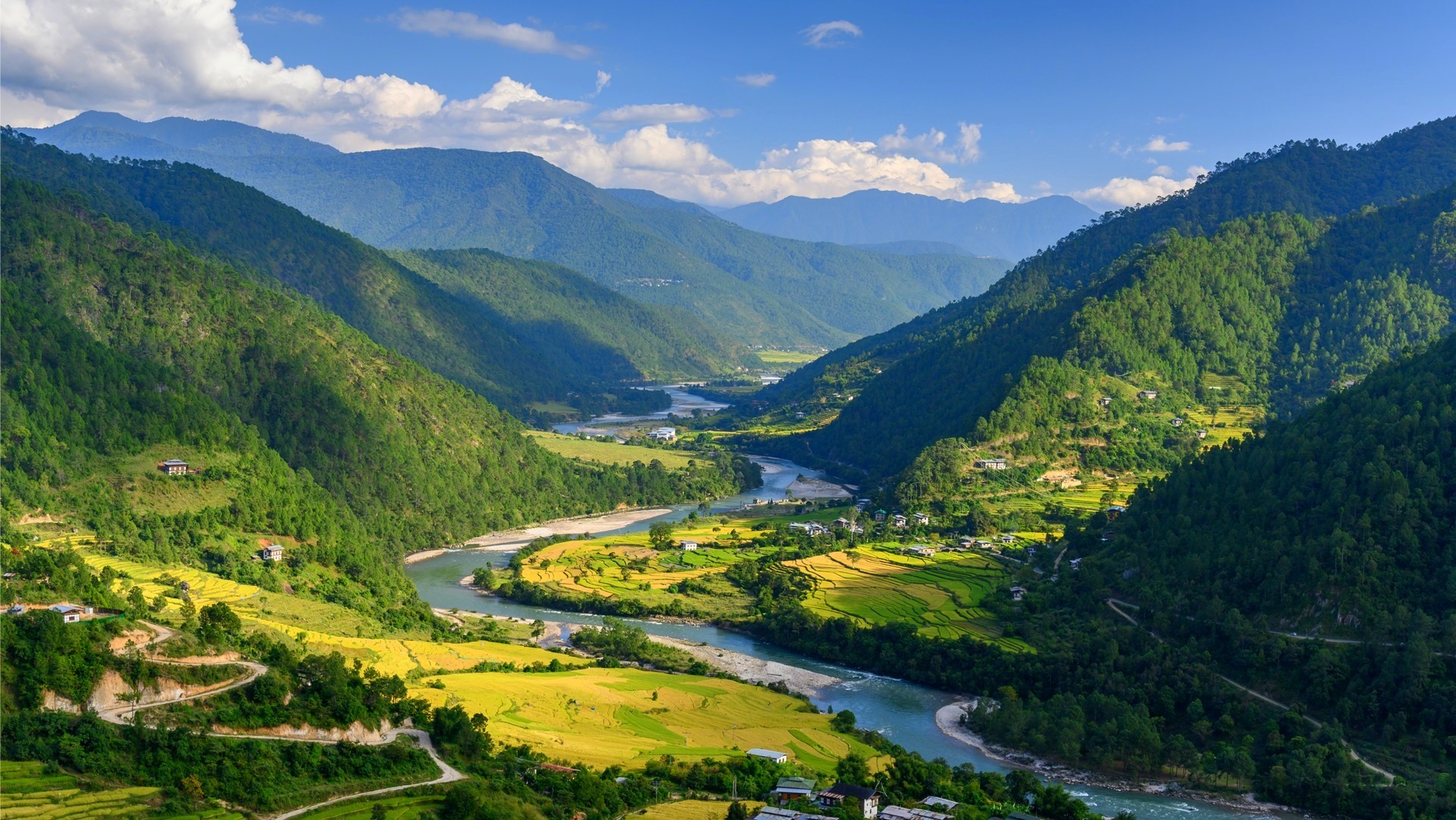
- Traditional Architecture: The homes in Ritsha Village are built in the classic Bhutanese style, featuring intricately painted woodwork and beautifully carved windows, which reflect the traditional craftsmanship of the region. These homes are typically constructed from local materials and are designed to withstand the varied climate of the area.
- Agricultural Lifestyle: Ritsha is often referred to as a 'model' rice growing village due to its advanced and efficient use of irrigation and farming techniques. The village's rice fields are a lush, vibrant green during the growing season and provide a scenic backdrop for visitors.
- Cultural Insight: Visiting Ritsha Village allows travelers to immerse themselves in the day-to-day activities of a Bhutanese farming community, offering insights into practices such as plowing, planting, harvesting, and threshing rice.
- Community and Family Structures: The village is characterized by its strong sense of community and the importance of family units. Social cohesion is reinforced through various communal activities and traditional festivals, which are celebrated with enthusiasm within the village.
- Tourist Attraction: While Ritsha does not experience the heavy footfall of more commercial tourist destinations, it attracts those who are interested in experiencing a deeper cultural connection and understanding the rural way of life in Bhutan. It’s an ideal place for cultural enthusiasts and photographers looking to capture the essence of Bhutanese village life.
Ritsha Village provides a profound experience for visitors looking to explore beyond the urban centers of Bhutan. It offers a unique opportunity to witness the harmonious balance between traditional practices and the natural environment, making it a must-visit for anyone seeking an authentic insight into Bhutan's rural heritage.
Talo Monastery
Talo Monastery is a serene and spiritually significant site nestled in the hills above Punakha, offering visitors a peaceful retreat with panoramic views of the surrounding valleys. Known for its religious importance and its beautiful setting, Talo Monastery is a key destination for those exploring the spiritual landscape of Bhutan. Here are some of the distinctive features and attractions of Talo Monastery:
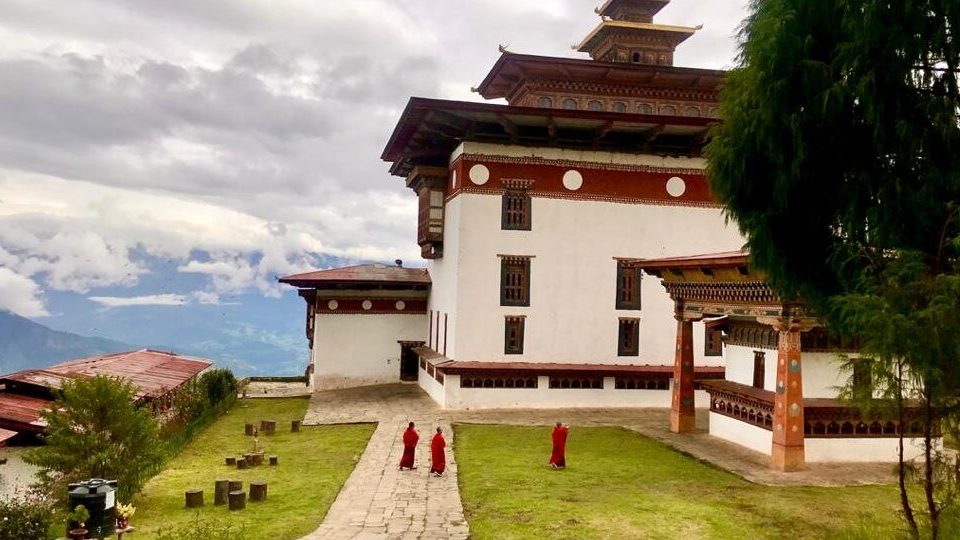
- Spiritual Significance: Talo Monastery is the seat of the mind incarnation of the Bhutanese Saint, Pema Lingpa. It holds a revered place in Bhutanese culture and spirituality, attracting monks and spiritual seekers from across the region. The monastery serves as a center for religious study and meditation.
- Architectural Beauty: The structure of Talo Monastery is a fine example of traditional Bhutanese architecture, featuring ornate wood carvings, intricate murals, and gilded statues. The well-preserved details and designs contribute to the monastery's tranquil and sacred atmosphere.
- Serene Location: Set high in the hills, the monastery offers stunning views of the lush, terraced fields and distant, snow-capped mountains. The tranquil environment is ideal for reflection and meditation, making it a popular destination for those seeking peace and solitude.
- Cultural Festivities: Talo Monastery is famous for its annual festival, the Talo Tshechu, which is held over three days. The festival features religious mask dances, music, and rituals that draw both locals and tourists. This event provides a colorful insight into the cultural and spiritual life of the community.
- Community and Heritage: The monastery plays an integral role in the local community, offering guidance and support to the villagers. It is also a custodian of many religious relics and artifacts, which are significant to the preservation of Bhutanese heritage.
- Accessibility: While the monastery is located in a somewhat remote area, it is accessible by road and a short hike. This accessibility allows visitors to combine a visit to Talo Monastery with other nearby attractions in Punakha.
Talo Monastery is not just a destination for religious pilgrimage but a beacon of cultural heritage, set against the backdrop of one of Bhutan's most picturesque landscapes. Whether you are drawn by its spiritual significance, architectural beauty, or simply the peace it offers, Talo Monastery provides a rewarding and enriching experience for all who visit.
Nalanda Buddhist Institute
Nalanda Buddhist Institute, also known as Dalayna Gompa, is a prestigious center of Buddhist learning nestled in the serene landscape of Punakha, Bhutan. This institute is not only a spiritual hub but also a place of profound learning and reflection for monks and laypersons alike. Here’s a closer look at what makes the Nalanda Buddhist Institute a significant and enriching site for visitors:
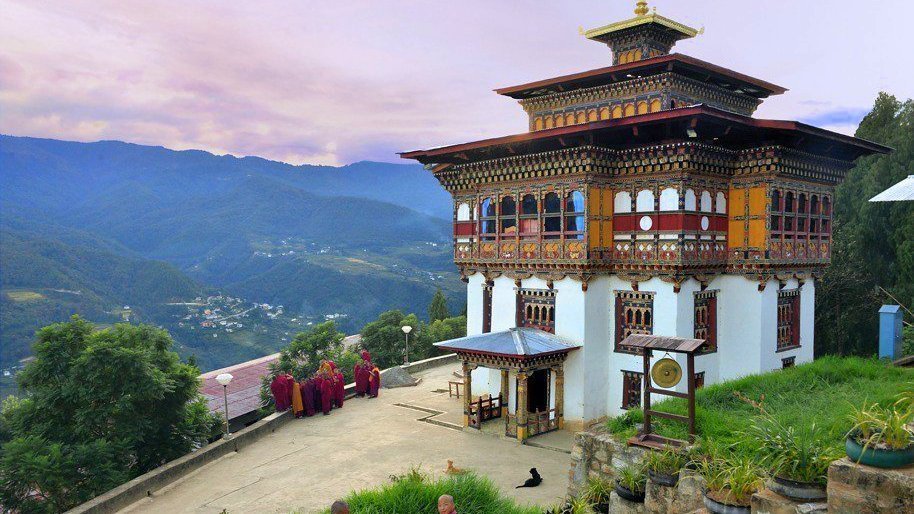
- Center for Buddhist Studies: Modeled after the ancient Nalanda University in India, this institute is dedicated to the advanced study of Buddhist philosophy and practices. It serves as a residential school for monks who pursue a deeper understanding of Buddhist texts, rituals, and meditation techniques.
- Architectural Splendor: The architecture of the institute is reflective of traditional Bhutanese style, featuring ornate wood carvings, vibrant murals, and intricate statues. These elements not only enhance the aesthetic appeal of the institute but also serve as tools for spiritual teaching and reflection.
- Spiritual Environment: Located high in the Himalayas, the setting of the Nalanda Buddhist Institute contributes to its tranquil atmosphere, ideal for meditation and study. The natural surroundings—comprising lush forests and clear skies—add to the peace and serenity that characterize this spiritual retreat.
- Public Engagement: Although primarily an educational institution for monks, Nalanda Buddhist Institute welcomes visitors seeking to understand or practice Buddhism. The institute often hosts seminars, prayer sessions, and meditation retreats that are open to both the local community and tourists.
- Cultural Insight: For those interested in the spiritual traditions of Bhutan, the institute offers a valuable insight into the monastic lifestyle and the practices of Mahayana Buddhism. Visitors can interact with the monks, participate in daily rituals, and gain a firsthand experience of Bhutanese religious practices.
- Community Impact: Beyond its religious and educational roles, the institute actively engages in community service and development projects. These activities reinforce the Buddhist principles of compassion and service to others, impacting the local community positively.
Nalanda Buddhist Institute is not merely an educational institution but a beacon of Buddhist thought and spirituality. It offers a unique opportunity for introspection and spiritual growth, set against the backdrop of Punakha’s breathtaking natural beauty. Whether you are a student of Buddhism, a practitioner, or simply a curious traveler, a visit to the Nalanda Buddhist Institute promises a deep and meaningful experience.
Mo Chhu River Rafting
Mo Chhu River Rafting offers an exhilarating and scenic adventure in the heart of Punakha, Bhutan. This popular outdoor activity draws thrill-seekers and nature lovers alike to experience the vibrant waterways that cut through the lush landscape of the valley. Here are some key highlights of rafting on the Mo Chhu River:
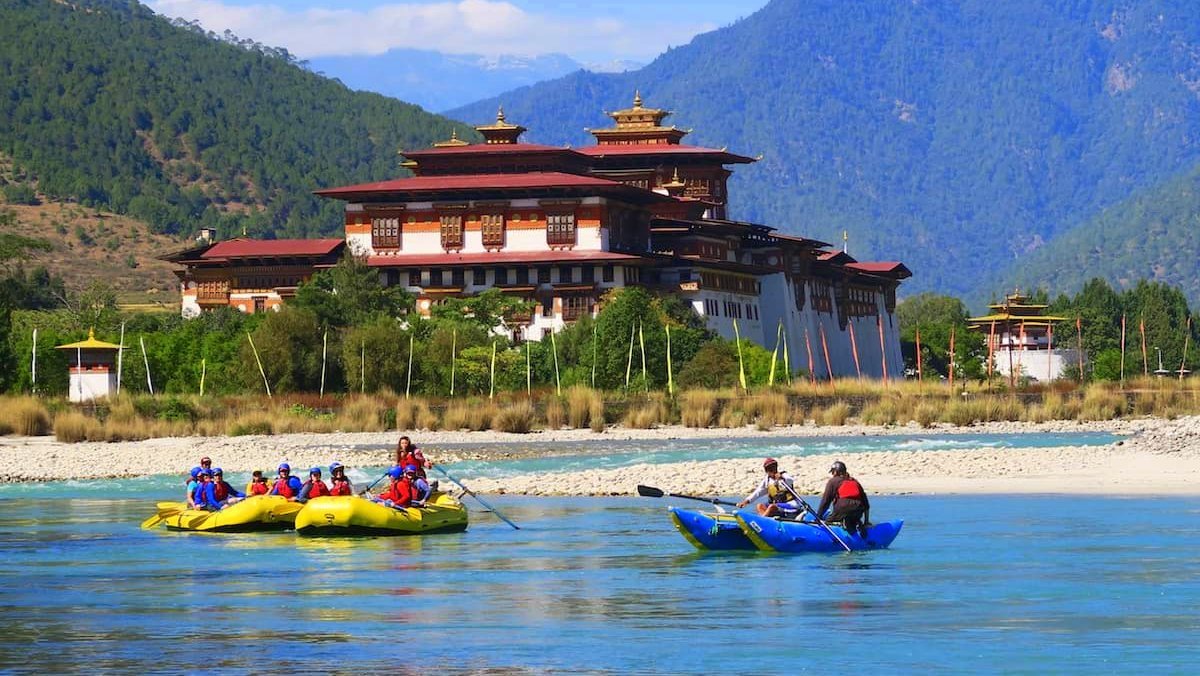
- Thrilling Rapids: The Mo Chhu River features a series of gentle to moderate rapids, making it suitable for both beginners and experienced rafters. The river's flow, combined with its rapids, provides a thrilling experience while ensuring safety for all participants.
- Scenic Beauty: As you navigate the waters, the rafting journey offers spectacular views of the surrounding Himalayan landscape, including dense forests and the majestic Punakha Dzong. Rafting here is not just an adventure sport but also an opportunity to immerse yourself in the natural beauty of Bhutan.
- Cultural Experience: The river flows near several historical and cultural sites, including the famed Punakha Dzong. This proximity allows rafters to enjoy unique perspectives of these landmarks, which are steeped in Bhutanese heritage.
- Wildlife Sightings: The riverbanks and surrounding forests are home to a variety of wildlife, providing chances to spot indigenous birds and perhaps even otters. This adds an element of wildlife watching to the rafting adventure.
- Family-Friendly: Mo Chhu River rafting is known for its relatively mild rapids in certain sections, making it an ideal choice for families and groups with varying levels of rafting experience. The activity provides a safe and enjoyable environment for everyone.
- Guided Tours: Rafting trips on the Mo Chhu are conducted by experienced and knowledgeable guides who ensure the safety of all participants while providing insights into the local flora, fauna, and cultural significance of the areas you pass through.
Mo Chhu River Rafting is a must-try activity in Punakha for anyone looking to add a dash of adventure to their Bhutanese journey. Whether you're seeking thrills, wanting to connect with nature, or simply looking to enjoy some time on the water, rafting on the Mo Chhu River offers a refreshing and memorable experience in one of the most beautiful settings in Bhutan.
Jigme Dorji National Park
Jigme Dorji National Park, named after the late King Jigme Dorji Wangchuck, is one of Bhutan's most ecologically diverse and significant conservation areas. Spanning over several districts including Punakha, this national park is a sanctuary for a wide range of flora and fauna, some of which are rare and endangered. Here are some highlights and attractions of Jigme Dorji National Park:
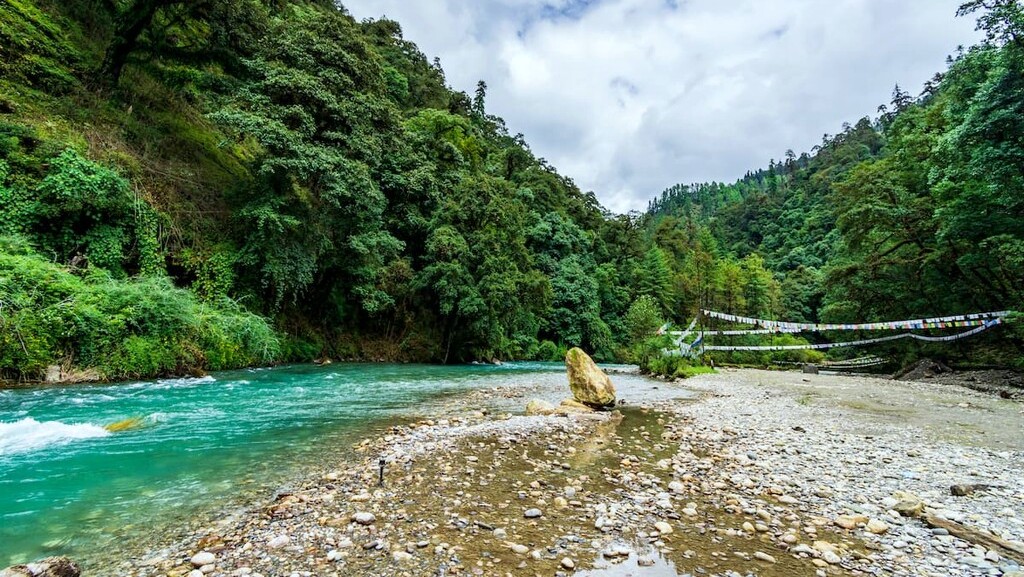
- Biodiversity Hotspot: The park is renowned for its rich biodiversity. It is home to many species of plants and animals, including the elusive snow leopard, the endangered Bengal tiger, and the Bhutan takin, which is the national animal of Bhutan.
- Varied Ecosystems: The park’s vast landscape encompasses a range of ecosystems from subtropical rainforests in the south to alpine meadows and permanent ice fields in the north. This variety allows for a broad spectrum of biodiversity and makes the park a fascinating study for ecologists and nature lovers alike.
- Cultural Sites: Jigme Dorji National Park is not only a natural reserve but also a cultural treasure. It includes several culturally important sites like the sacred Mount Jomolhari and numerous hermitages and monasteries, which are significant for local communities and pilgrims.
- Adventure and Trekking: The park offers numerous trekking routes that vary in difficulty, providing challenges for both novice trekkers and experienced mountaineers. The most famous trek is the Jomolhari Loop, which offers stunning views of Mount Jomolhari at the border between Bhutan and Tibet.
- Wildlife Watching: For wildlife enthusiasts, the park offers opportunities to observe animals in their natural habitats. Guided wildlife safaris can be arranged, where visitors might see red pandas, blue sheep, and various bird species, including the rare and beautiful black-necked crane.
- Conservation Efforts: The park plays a crucial role in Bhutan’s conservation efforts. It is actively involved in the protection of its wildlife and habitats, research on flora and fauna, and the promotion of sustainable tourism practices that benefit local communities and the environment.
Jigme Dorji National Park is not just a place of natural beauty but also a vital center for biodiversity conservation, cultural heritage, and eco-tourism. Its stunning landscapes and rich wildlife make it a must-visit destination for anyone traveling to Bhutan, offering a unique blend of adventure, education, and spiritual reflection.
Punakha, with its historical significance and natural splendor, offers a diverse range of experiences that cater to the spiritual, adventurous, and cultural interests of any visitor. From the architectural grandeur of Punakha Dzong to the serene and educational atmosphere of the Nalanda Buddhist Institute, and the adrenaline-pumping Mo Chhu River Rafting, each site provides a unique window into the heart of Bhutanese heritage and natural beauty. The tranquility of Talo Monastery, the vibrant community life at Ritsha Village, and the rich biodiversity of Jigme Dorji National Park further enrich the travel experience, making Punakha a quintessential destination that embodies the essence of Bhutan. Whether you are seeking a spiritual journey, cultural immersion, or natural exploration, Punakha’s top places promise unforgettable memories and insights into a land steeped in tradition and natural wonder.
FAQs of the Top 10 Places to visit in Punakha
Q: What is the best time to visit Punakha?
A: The best time to visit Punakha is during the spring months of March to May when the weather is warm, and the valley is lush, or during autumn from September to November, which offers clear skies and pleasant temperatures.
Q: How do I reach Punakha from Thimphu?
A: Punakha is approximately a 2-3 hour drive from Thimphu. The journey takes you over the scenic Dochula Pass, offering stunning panoramic views of the Himalayan range.
Q: Are there any entrance fees for Punakha Dzong?
A: Yes, there is a small entrance fee for visitors to Punakha Dzong. This fee contributes to the maintenance and preservation of the site.
Q: Is it necessary to hire a guide for visiting these sites in Punakha?
A: While it's not mandatory, hiring a guide can enhance your experience as they provide valuable insights into the historical and cultural contexts of each site. Guides are particularly recommended for trekking activities and visits to religious sites.
Q: Can I visit Jigme Dorji National Park on my own?
A: While you can visit the park independently, it is advisable to go with a guide who can help navigate the trails and increase the chances of wildlife sightings, besides ensuring your safety.
Q: What should I wear when visiting religious sites in Punakha?
A: When visiting religious sites, it is important to dress modestly. Shoulders and legs should be covered, and hats should be removed as a sign of respect.
Q: Are there facilities for food and accommodation near these tourist sites?
A: Punakha offers a range of accommodation options from luxury resorts to more modest guesthouses. Many of these facilities have in-house restaurants, and there are also standalone eateries available, especially near popular tourist spots.
Q: What are some must-do activities in Punakha besides visiting historical sites?
A: Apart from historical tours, activities like river rafting on the Mo Chhu, hiking to Khamsum Yulley Namgyal Chorten, and participating in local festivals are highly recommended.
Q: How much time should I allocate for a visit to Chimi Lhakhang?
A: A visit to Chimi Lhakhang typically takes about 1 to 2 hours, depending on how much time you spend exploring the temple grounds and surrounding village.
Q: Is Punakha suitable for family trips?
A: Absolutely! Punakha is a family-friendly destination with activities and sites that cater to all ages, from scenic nature walks and light treks to cultural education and relaxing river experiences.
If you are looking for tour packages in Bhutan please click here
If you need any further information, please contact us, Email: at [email protected] , Phone (Whatsapp or Viber) +975-1755-6636
